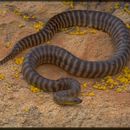Aspidites is a genus of pythons endemic to Australia. The name can be translated as "shield bearer" and pertains to the symmetrically shaped head scales. Currently, two species are recognized.[2]
Description
These snakes lack the heat-sensitive pits between the labial scales that most other python species have.
The head is slightly wider than the neck, and the eyes are small, with a vertically elliptic pupils.[3]
Distribution and habitat
They are found in Australia except in the south of the country.[1]
Behavior
Both species are nocturnal,[4] and terrestrial.[5]
Reproduction
Oviparous, the females stay with their eggs until they hatch.
Species
Species
[2] Taxon author
[2] Common name
[4] Geographic range
[1] A. melanocephalusT 
(
Krefft, 1864)
Black-headed python Australia in the northern half of the country, excluding the very arid regions.
A. ramsayi 
(
Macleay, 1882)
Woma python Australia in the west and center of the country: from
Western Australia through southern
Northern Territory and northern
South Australia to southern
Queensland and northwestern
New South Wales. Its range may be discontinuous.
T) Type species.[1]
Taxonomy
Two new subspecies, A. ramsayi panoptes, the western woma python, and A. r. richardjonesii, the desert woma python, were described by Hoser (2001).[6] However, these descriptions are questionable, as they do not include proper diagnoses and seem to be based only on distribution.[6] [7]
References
-
^ a b c d McDiarmid RW, Campbell JA, Touré T. 1999. Snake Species of the World: A Taxonomic and Geographic Reference, Volume 1. Herpetologists' League. 511 pp. ISBN 1-893777-00-6 (series). ISBN 1-893777-01-4 (volume).
-
^ a b c "Aspidites". Integrated Taxonomic Information System. Retrieved 9 September 2007.
-
^ Boulenger GA. 1893. Catalogue of the Snakes in the British Museum (Natural History). Volume I., Containing the Families...Boidæ... Trustees of the British Museum (Natural History). (Taylor and Francis, Printers.) London. xiii + 448 pp. + Plates I.- XXVIII. (Genus Aspidites, p. 91.)
-
^ a b Mehrtens JM. 1987. Living Snakes of the World in Color. New York: Sterling Publishers. 480 pp. ISBN 0-8069-6460-X.
-
^ Goin CJ, Goin OB, Zug GR. 1978. Introduction to Herpetology, Third Edition. W.H. Freeman. San Francisco. xi + 378 pp. ISBN 0-7167-0020-4. (Aspidites, p. 319.)
-
^ a b Aspidites ramsayi at the Reptarium.cz Reptile Database. Accessed 9 September 2007.
-
^ Wüster W, Bush B, Keogh JS, O'Shea M, Shine R. 2001. Taxonomic contributions in the "amateur" literature: comments on recent descriptions of new genera and species by Raymond Hoser. Litteratura Serpentium 21: 67-91. PDF Archived 9 August 2007 at the Wayback Machine at Wolfgang Wüster Archived 25 September 2006 at the Wayback Machine. Accessed 10 September 2007.

